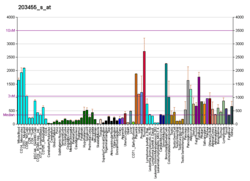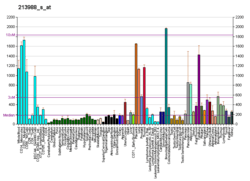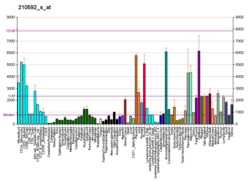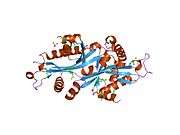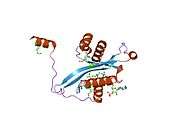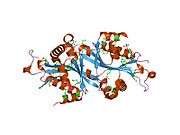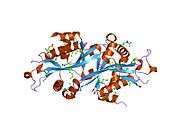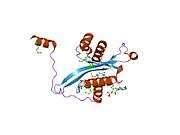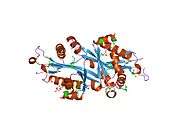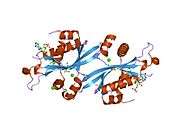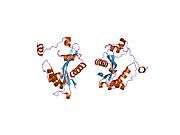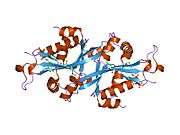SAT1 (gene)
Diamine acetyltransferase 1 is an enzyme that in humans is encoded by the SAT1 gene found on the X chromosome.[5][6][7]
Function
Spermidine/spermine N(1)-acetyltransferase (SPD/SPM acetyltransferase) is a rate-limiting enzyme in the catabolic pathway of polyamine metabolism. It catalyzes the N(1)-acetylation of spermidine and spermine and, by the successive activity of polyamine oxidase, spermine can be converted to spermidine and spermidine to putrescine.[7]
Clinical significance
An association with Keratosis follicularis spinulosa decalvans has been suggested.[8]
Elevated levels of RNA transcripts of SAT1 in the bloodstream have been associated with a higher risk of suicide.[9][10][11]
References
- 1 2 3 GRCh38: Ensembl release 89: ENSG00000130066 - Ensembl, May 2017
- 1 2 3 GRCm38: Ensembl release 89: ENSMUSG00000025283 - Ensembl, May 2017
- ↑ "Human PubMed Reference:".
- ↑ "Mouse PubMed Reference:".
- ↑ Casero RA, Celano P, Ervin SJ, Applegren NB, Wiest L, Pegg AE (January 1991). "Isolation and characterization of a cDNA clone that codes for human spermidine/spermine N1-acetyltransferase". The Journal of Biological Chemistry. 266 (2): 810–4. PMID 1985966.
- ↑ Xiao L, Celano P, Mank AR, Griffin C, Jabs EW, Hawkins AL, Casero RA (September 1992). "Structure of the human spermidine/spermine N1-acetyltransferase gene (exon/intron gene organization and localization to Xp22.1)". Biochemical and Biophysical Research Communications. 187 (3): 1493–502. doi:10.1016/0006-291X(92)90471-V. PMID 1417826.
- 1 2 "Entrez Gene: SAT1 spermidine/spermine N1-acetyltransferase 1".
- ↑ Gimelli G, Giglio S, Zuffardi O, Alhonen L, Suppola S, Cusano R, Lo Nigro C, Gatti R, Ravazzolo R, Seri M (September 2002). "Gene dosage of the spermidine/spermine N(1)-acetyltransferase ( SSAT) gene with putrescine accumulation in a patient with a Xp21.1p22.12 duplication and keratosis follicularis spinulosa decalvans (KFSD)". Human Genetics. 111 (3): 235–41. doi:10.1007/s00439-002-0791-6. PMID 12215835.
- ↑ Honor Whiteman (21 August 2013). "'Biological signal' of suicide risk found in blood". Medical News Today. Retrieved 21 August 2013.
- ↑ Le-Niculescu H, Levey DF, Ayalew M, Palmer L, Gavrin LM, Jain N, Winiger E, Bhosrekar S, Shankar G, Radel M, Bellanger E, Duckworth H, Olesek K, Vergo J, Schweitzer R, Yard M, Ballew A, Shekhar A, Sandusky GE, Schork NJ, Kurian SM, Salomon DR, Niculescu AB (December 2013). "Discovery and validation of blood biomarkers for suicidality". Molecular Psychiatry. 18 (12): 1249–64. doi:10.1038/mp.2013.95. PMC 3835939. PMID 23958961.
- ↑ http://medicalxpress.com/news/2013-08-biomarkers-blood-suicide.html
Further reading
- Lake JA, Carr J, Feng F, Mundy L, Burrell C, Li P (February 2003). "The role of Vif during HIV-1 infection: interaction with novel host cellular factors". Journal of Clinical Virology. 26 (2): 143–52. doi:10.1016/S1386-6532(02)00113-0. PMID 12600646.
- Xiao L, Celano P, Mank AR, Pegg AE, Casero RA (August 1991). "Characterization of a full-length cDNA which codes for the human spermidine/spermine N1-acetyltransferase". Biochemical and Biophysical Research Communications. 179 (1): 407–15. doi:10.1016/0006-291X(91)91385-P. PMID 1652956.
- Libby PR, Ganis B, Bergeron RJ, Porter CW (February 1991). "Characterization of human spermidine/spermine N1-acetyltransferase purified from cultured melanoma cells". Archives of Biochemistry and Biophysics. 284 (2): 238–44. doi:10.1016/0003-9861(91)90291-P. PMID 1989509.
- Casero RA, Celano P, Ervin SJ, Wiest L, Pegg AE (September 1990). "High specific induction of spermidine/spermine N1-acetyltransferase in a human large cell lung carcinoma". The Biochemical Journal. 270 (3): 615–20. doi:10.1042/bj2700615. PMC 1131776. PMID 2241897.
- Casero RA, Gabrielson EW, Pegg AE (August 1994). "Immunohistochemical staining of human spermidine/spermine N1-acetyltransferase superinduced in response to treatment with antitumor polyamine analogues". Cancer Research. 54 (15): 3955–8. PMID 8033120.
- Xiao L, Casero RA (January 1996). "Differential transcription of the human spermidine/spermine N1-acetyltransferase (SSAT) gene in human lung carcinoma cells". The Biochemical Journal. 313 (2): 691–6. doi:10.1042/bj3130691. PMC 1216962. PMID 8573111.
- Coleman CS, Huang H, Pegg AE (June 1996). "Structure and critical residues at the active site of spermidine/spermine-N1-acetyltransferase". The Biochemical Journal. 316 (3): 697–701. doi:10.1042/bj3160697. PMC 1217406. PMID 8670140.
- Bordin L, Vargiu C, Colombatto S, Clari G, Testore G, Toninello A, Grillo MA (December 1996). "Casein kinase 2 phosphorylates recombinant human spermidine/spermine N1-acetyltransferase on both serine and threonine residues". Biochemical and Biophysical Research Communications. 229 (3): 845–51. doi:10.1006/bbrc.1996.1890. PMID 8954982.
- Bettuzzi S, Davalli P, Astancolle S, Carani C, Madeo B, Tampieri A, Corti A, Saverio B, Pierpaola D, Serenella A, Cesare C, Bruno M, Auro T, Arnaldo C (January 2000). "Tumor progression is accompanied by significant changes in the levels of expression of polyamine metabolism regulatory genes and clusterin (sulfated glycoprotein 2) in human prostate cancer specimens". Cancer Research. 60 (1): 28–34. PMID 10646846.
- Simpson JC, Wellenreuther R, Poustka A, Pepperkok R, Wiemann S (September 2000). "Systematic subcellular localization of novel proteins identified by large-scale cDNA sequencing". EMBO Reports. 1 (3): 287–92. doi:10.1093/embo-reports/kvd058. PMC 1083732. PMID 11256614.
- Coleman CS, Pegg AE (August 2001). "Polyamine analogues inhibit the ubiquitination of spermidine/spermine N1-acetyltransferase and prevent its targeting to the proteasome for degradation". The Biochemical Journal. 358 (Pt 1): 137–45. doi:10.1042/0264-6021:3580137. PMC 1222041. PMID 11485561.
- Bordin L, Vargiu C, Clari G, Brunati AM, Colombatto S, Salvi M, Grillo MA, Toninello A (January 2002). "Phosphorylation of recombinant human spermidine/spermine N(1)-acetyltransferase by CK1 and modulation of its binding to mitochondria: a comparison with CK2". Biochemical and Biophysical Research Communications. 290 (1): 463–8. doi:10.1006/bbrc.2001.6204. PMID 11779193.
- Nikiforova NN, Velikodvorskaja TV, Kachko AV, Nikolaev LG, Monastyrskaya GS, Lukyanov SA, Konovalova SN, Protopopova EV, Svyatchenko VA, Kiselev NN, Loktev VB, Sverdlov ED (June 2002). "Induction of alternatively spliced spermidine/spermine N1-acetyltransferase mRNA in the human kidney cells infected by venezuelan equine encephalitis and tick-borne encephalitis viruses". Virology. 297 (2): 163–71. doi:10.1006/viro.2002.1456. PMID 12083816.
- Gimelli G, Giglio S, Zuffardi O, Alhonen L, Suppola S, Cusano R, Lo Nigro C, Gatti R, Ravazzolo R, Seri M (September 2002). "Gene dosage of the spermidine/spermine N(1)-acetyltransferase ( SSAT) gene with putrescine accumulation in a patient with a Xp21.1p22.12 duplication and keratosis follicularis spinulosa decalvans (KFSD)". Human Genetics. 111 (3): 235–41. doi:10.1007/s00439-002-0791-6. PMID 12215835.
- Tomitori H, Nenoi M, Mita K, Daino K, Igarashi K, Ichimura S (December 2002). "Functional characterization of the human spermidine/spermine N(1)-acetyltransferase gene promoter". Biochimica et Biophysica Acta. 1579 (2–3): 180–4. doi:10.1016/S0167-4781(02)00545-6. PMID 12427553.
- Izmailova E, Bertley FM, Huang Q, Makori N, Miller CJ, Young RA, Aldovini A (February 2003). "HIV-1 Tat reprograms immature dendritic cells to express chemoattractants for activated T cells and macrophages". Nature Medicine. 9 (2): 191–7. doi:10.1038/nm822. PMID 12539042.
This article is issued from
Wikipedia.
The text is licensed under Creative Commons - Attribution - Sharealike.
Additional terms may apply for the media files.





